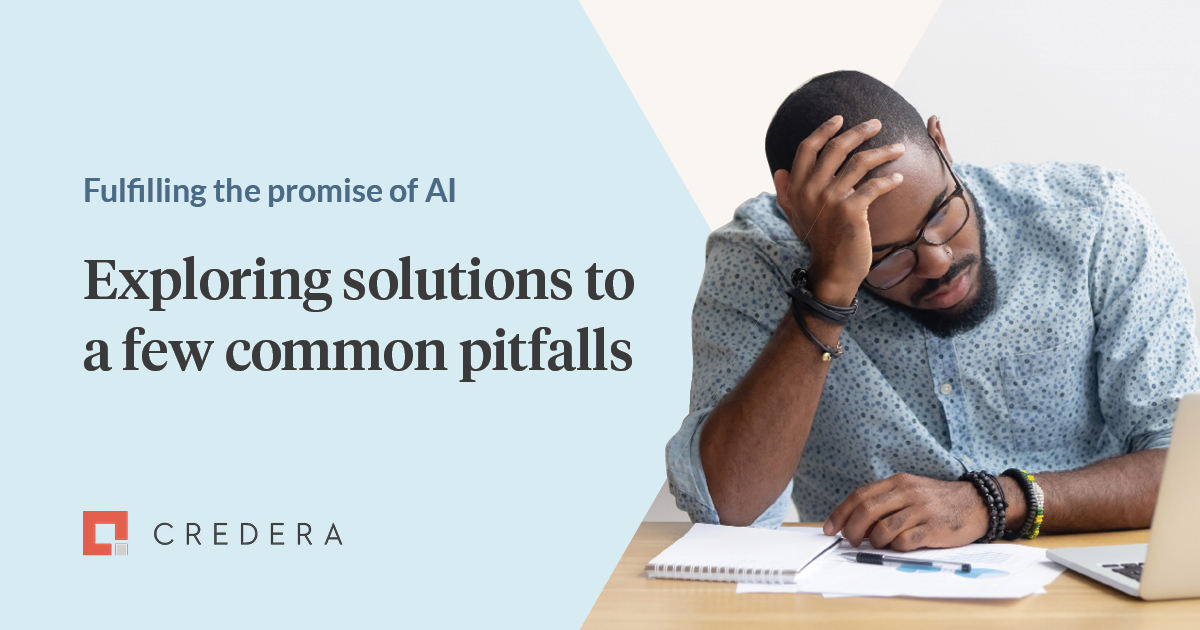
[Following is an excerpt from an ebook by Credera’s Chief Technology Officer—download the ebook to read more.]
As artificial intelligence (AI) reshapes the business landscape, organizations in all sectors are looking for opportunities to use it to drive revenue, offer new services, boost efficiency, and stay ahead of the competition. McKinsey estimates that generative AI could increase the impact of all artificial intelligence by up to 40% and add between $2.6 trillion and $4.4 trillion to the global economy.
Yet most organizations aren’t prepared to fully embrace these technologies. In fact, Gartner estimates that 85% of AI implementations fall short of expectations or aren’t completed at all. Those are pretty bad results, especially for something that’s supposed to change the world with its “intelligence.”
It’s obvious that AI has the potential to generate significant business value, but to unlock that value, it’s essential to understand why so many AI projects fail. Laying the right foundation and identifying roadblocks before you start can significantly improve your chances. Here’s a look at four critical factors to consider.
1. Business need
Without a clearly defined business need, your AI initiatives are just a solution in search of a problem. A recent Gartner survey found that the biggest barriers to AI adoption for half the companies surveyed was being able to demonstrate value of the solution.
It's imperative to start with the problem you’re trying to solve and the specific measures you’ll use to evaluate the success of the project (e.g., increased revenue, increased conversion, decreased costs, etc.). Starting with the problem not only puts boundaries around the solution, preventing scope creep, but it also allows the ROI of the project to be accurately measured.
For example, at Credera, we worked with a hotel company that wanted to increase conversions (property bookings) on its website. We used generative AI to create the property descriptions “on the fly” based on customer profiles and travel histories. Having a specific goal and relevant metrics defined enabled us to conduct a focused implementation that quickly demonstrated ROI.
Conversely, if you start with “let’s use generative AI” as a goal, you can spend many cycles prototyping different tools across a number of use cases, none of which ultimately drive value.
2. Governance model
Like any new technology, AI requires appropriate governance to make sure the costs and risks are well managed. But this governance needs to be “right-sized.” Too little governance results in unnecessary duplications, higher costs, and issues with trust and safety. But too much can be constraining, preventing solutions from creating value.
It’s a difficult balance to manage, but risk-based processes and automation can help find the “goldilocks zone.”
3. Good data
Data is the lifeblood of AI. If your data isn’t clean, integrated, accessible—and appropriate for your needs—your AI models won’t be able to deliver accurate and reliable insights. Investing in robust data management practices is non-negotiable.
Clean data requires good data governance to reduce errors, inconsistencies, and duplicates. While no data set can be completely clean, you need mechanisms in place to ensure that your data is “good enough” for use with AI.
Part of having “clean” data is also ensuring that unintentional bias and other issues don’t creep in. This requires implementing robust data governance practices, conducting regular audits, and using automated tools for data validation and correction.
Additionally, involving diverse teams in the data collection and analysis process can help identify and mitigate potential biases, ensuring that the data accurately represents the intended population and leads to fair and effective AI outcomes.
Integrated data involves bringing together data from different sources and systems. An example of this might be integrating customer purchase data from a website with customer support interaction data from a separate CRM system. Without data from all these sources, it's difficult to get a complete view of the customer, which limits the value AI can drive.
Accessible means the data is easily available to models and applications, but security and privacy measures must be in place. For example, employee records must be accessible to HR personnel for administrative purposes, but sensitive information, like Social Security numbers, salaries, and medical records, should be protected with encryption and access controls. Without appropriate controls on your data, you risk unauthorized access, data breaches, and misuse of sensitive information, eliminating any gains from using AI.
Like AI governance, good data governance is necessary to achieve all these things.
4. Scalable infrastructure and high computing capacity
AI projects require significant computational power and storage. If your infrastructure isn’t scalable or secure or lacks the necessary bandwidth and computing capacity, your AI initiatives will face bottlenecks, delays, and security risks.
By providing scalable, secure, and high-performance infrastructure, the cloud is a primary solution to these problems. Cloud platforms such as AWS, Google Cloud, and Azure offer the robust computing resources, vast storage capabilities, and advanced security features needed for AI use cases.
The bottom line
Understanding the reasons behind AI project failures is crucial for successful implementation. Identifying the specific challenges your organization faces and taking steps to address them before you get started will help ensure that your AI projects solve real problems and deliver tangible value.
While many consultancies provide generic, high-level solutions, Credera develops specific, actionable plans our clients can follow, with realistic, detailed solutions to their AI-related issues. Schedule a call with our specialists to get started.
[Download the ebook to learn more about setting your AI projects up for success.]
Contact Us
Ready to achieve your vision? We're here to help.
We'd love to start a conversation. Fill out the form and we'll connect you with the right person.
Searching for a new career?
View job openings
